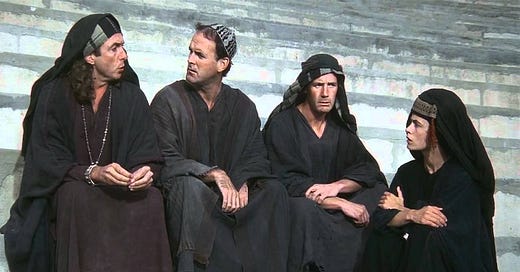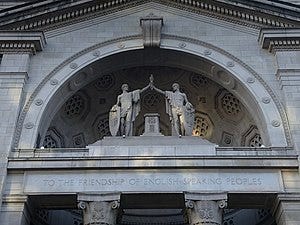This week, Americans celebrate our independence from Great Britain.
Yet like “My Country ‘Tis of Thee” sung to the tune of “God Save the King,” the melody of our American present is firmly founded on the songs of the English past.
This is true in so many aspects of law, language, literature, and custom. But today I want to reveal one norm that is surprisingly and thoroughly British: treating cantors as clergy.
In America, this idea faced immense pushback, particularly among American rabbis. How could laypeople of an artistic temperament, schooled in sacred chant but only sometimes in rigorous rabbinics, possibly hold a ministerial status? In 1966 the Cantors Assembly successfully fought in Federal Court for cantors to receive ministerial benefits under US tax law.1 But even if American law recognized them as ministers, this was a far cry from an established social and religious norm of respect.
Great Britain, in contrast, provided a surprising foundation for the dignity of the cantorial office.2
Beyond the Music is a reader-supported guide to Jewish music, arts, and culture. If you want to support my work, the best way is by taking out a paid subscription.
Many norms of American Jewish life are undeniably British. The United Synagogue of Conservative Judaism, founded in 1913, was originally conceived of by the Anglo-Jewish academic, Solomon Schechter, as a parallel to the United Synagogue in Great Britain, and even his own religious concepts relied on Anglican ideas and terms. American-Jewish music is also indebted to this British influence, as Schechter’s wife Mathilde published a hymnal which includes several British melodies now in use throughout American synagogues.

Perhaps even more surprising is that Great Britain deserves credit for having the first cantorial school in history.
Predating American cantorial schools by almost a century, London’s Jews’ College was founded in 1855 to afford a “liberal and useful Hebrew and English education to the sons of respectable parents, and training of Ministers, Readers and Teachers.”3 The term “Reader” here refers to cantors, a phenomenon which we will return to shortly. It is notable that Albert Hyamson, the chronicler of the first century of Jews’ College, wrote that the ministering function in Britain was firstly a cantorial one:
“The office of minister or preacher in the Anglo-Jewish Community developed out of that of the Chazan or Reader or Leader in the prayers. The Haham, or among the Ashkenazim the Rabbi of the Congregation, used to give occasional addresses, but these were very exceptional and not until the nineteenth century in English. Such addresses in English were also[,] exceptionally in the early nineteenth century, given by laymen…”4
According to Hyamson’s account (which includes numerous examples), the cantor in the late eighteenth and nineteenth centuries was equally (if not more) expected to be able to give sermons in the English than his rabbinic counterpoints. Perhaps it is because the overwhelming majority of these early cantors were born in England as second-generation immigrants, and thus could give over religious instruction and homiletics in the vernacular according to the desires of their congregations.
To give a sermon, to lead prayers, and or performing life-cycle events makes someone, in the English-speaking world, a minister. This was true in nineteenth-century Great Britain. It was also the Cantors Assembly’s contention one hundred years later, when the organization successfully advocated for its members to have legal ministerial status. Yet suggestions of the ministerial status of the cantor in America predates even this, going back to the first American cantors union founded in 1897, the Jewish Ministers Cantors Association (Yid. Chazonim Varband). It is out of such recognition that cantors (and even some lay bar mitzvah tutors/service leaders), prior to the days of cantorial schools and ordination, were given the title “Reverend.”
From whence cometh such Christian terminology? Like the Schechters’ adaptation of Anglican ideas and ecclesiastical structure to their new vision for the American synagogue, I believe that the idea of the cantor as reverend derives from the Anglican church and the history of the office of the “Reader".”
The ministry of Reader is an office dating back to the early church, and is still retained by Catholic and Anglican clergy. In an attempt to strengthen the nascent Church of England, Queen Elizabeth revived the Reader’s office in the sixteenth century, so as to grow the ranks of her ministering churchmen and to empower enthusiastic laypeople to lead the new national faith. Elizabethan Readers were commissioned by the Bishopric, and many of them served in small parishes by themselves. They led services, preached, and taught religion in their local communities.
Sound familiar?
While a surge in university-educated Anglican priests caused a lull in the Readership ministry in the seventeenth and eighteenth centuries, the nineteenth century once again became a time of revival. Victorian England saw threats from non-conformist denominations of Christianity, and once again the Anglican Church empowered its laypeople to enthusiastically minister in the Office of Reader.5
This development coincides with not only the growth of Jewish life in England, but the characterization of the Office of the Hazzan as a “Reader.” The parallels between the Anglican and the Jewish Readers are many: the speaking of the liturgy, the giving of sermons, and ministry in community. Both communities faced a lack of ordained clergy and a need for strengthening local communities with ministers. Thus both classes of lay sacred workers were vested with the role of Reader and the honorific of “Reverend” — a title which became the norm for American and British communities through the mid-twentieth century.6
The proliferation of “Reverends” was also a part of the unique rabbinic norms of the British Chief Rabbinate, which in its early days would not allow any other rabbis to use their title — for many years, the Chief Rabbi was the only functioning rabbi in Britain. Rabbis not-in-chief were called “ministers,” and as the great Anglo-Jewish Encyclopedist Michael Jolles points out, had overlapping roles with Readers/Cantors throughout the nineteenth century. Yet eventually cantors would also be referred to as “ministers,” certainly by the era of the Association of Ministers (Chazzanim) of Great Britain, the first British cantorial association founded in 1905. Though terminology has standardized since then, Readers / Cantors served diverse forms of ministry, musical and religious through the mid-twentieth century. Rabbis largely supplanted these cantor-ministers (as well as the tradition of cantors and choirs) over the last fifty years, but a new generation of cantors is now working to restore the reverend dignity of the Anglo-Jewish Reader.7
In our modern day we identify the cantor as an “ordained” ministry. Yet its first dignity is more aligned with the spirit of lay empowerment and the high ideals and honorifics associated with the office of the Reader.
For that, this week may we thank our British co-religionists and proudly declare our interdependence.
The Cantors Assembly, under the legal representation of Herbert S. Garten, esq., secured ministerial benefits for all American cantors in the areas of parsonage, selective service, and social security via three separate U.S. federal court cases (1966, 1967, 1973), with the final IRS directive (Rev. Rul. 78-301) emerging in 1978. The full legal details can be found in Solomon Mendelson ed., Jubilee Journal of the Cantors Assembly 1947-1997 (New York: Cantors Assembly, 1998): 376-393.
My thanks to Cantor Zoe Jacobs, Alex Klein, David Prager, and Rabbi Jeremy Gordon who provided feedback on a draft of this article. My thanks also to Rev. Jo Kershaw for first alerting me to the history of the transformation of the office of the Reader.
Albert M. Hyamson, Jews College, London 1855-1955 (London: Jews’ College, 1954): 19.
ibid, 15ff.
For a full history, see Peter Garner, The Reader: an exploration of the history and present place of Reader ministry in the Church of England, Phd Diss., (University of Leeds, 2010): 39-109.
My British colleagues have told me that even today, “Reverend” is a title that refers to a cantor, especially a graduate of a school, who is authorized by the Chief Rabbinate to perform life cycle events, as well as to preach and conduct services. The term “Reader,” however, has been largely discontinued in lieu of Cantor or Chazzan.
Alas, there are very few full-time cantors working in Britain today. Yet number of recent British graduates of HUC-JIR — Cantors Zoë Jacobs (Finchley) , Tamara Hope Wolfson (Edgware & Hendon) , and Rachel Weston (Leeds)— are serving in serious leadership roles in keeping with the British tradition of the Reader.








Thanks for the nice teaching.